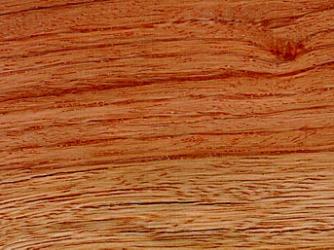 RED ZEBRANO - EBIARA
RED ZEBRANO - EBIARA

Other Common Names: Ekpogoi (Nigeria), Ebiara (Gabon), Melegba (Ivory Coast), Essaben, Abem (Cameroon).
Distribution: West Africa and reaching into Zaire. Found in various forest types: savanna formations, marshy localities, or dense high forests.
The Tree: Reaches a height of 100 to 130 ft, boles often irregular, sometimes fluted with low buttresses; trunk diameters 3 to 5 ft.
The Wood:
General Characteristics: Heartwood brown, pinkish brown to deep red brown, with dark purple or brown streaking; sapwood rather wide, whitish, often with a pink tint, clearly demarcated. Texture medium to coarse; grain straight, interlocked, or irregular; without characteristic odor or taste when dry. Traumatic gum ducts frequently present.
Weight: Basic specific gravity (ovendry weight/green volume) averaging about 0.58; air-dry density 44 pcf.
Mechanical Properties: (2-cm standard)
Moisture content Bending strength Modulus of elasticity Maximum crushing strength
(%) (Psi) (1,000 psi) (Psi)
Green (40) 10,500 1,320 4,930
12% 15,300 1,570 7,690
12% (46) 17,200 1,720 8,000
12% (46) 13,200 1,270 8,000
Janka side hardness 1,000 lb for green material and 1,360 lb for dry. Amsler toughness 180 in.-lb for dry material (2-cm specimen).
Drying and Shrinkage: Seasons rather slowly and well with only occasional degrade due to warping. Kiln schedule T6-D2 is suggested for 4/4 stock and T3-D1 for 8/4. Shrinkage green to ovendry: radial 4.4%; tangential 8.9%; volumetric 12.4%. Movement in service is rated as medium.
Working Properties: Saws easily and generally works well with hand and machine tools but there is some tearing of interlocked grain; good gluing properties; rated as a moderate steam-bending wood.
Durability: Heartwood durability variable with species, generally moderately resistant to attack by decay fungi and moderately resistant to termite attack. Logs liable to severe attack by ambrosia beetles and sapwood vulnerable to powder-post beetles.
Preservation: Heartwood is rated as resistant to preservative treatments, sapwood is permeable.
Uses: Heavy construction, furniture and cabinetwork, decorative veneers, paneling.






